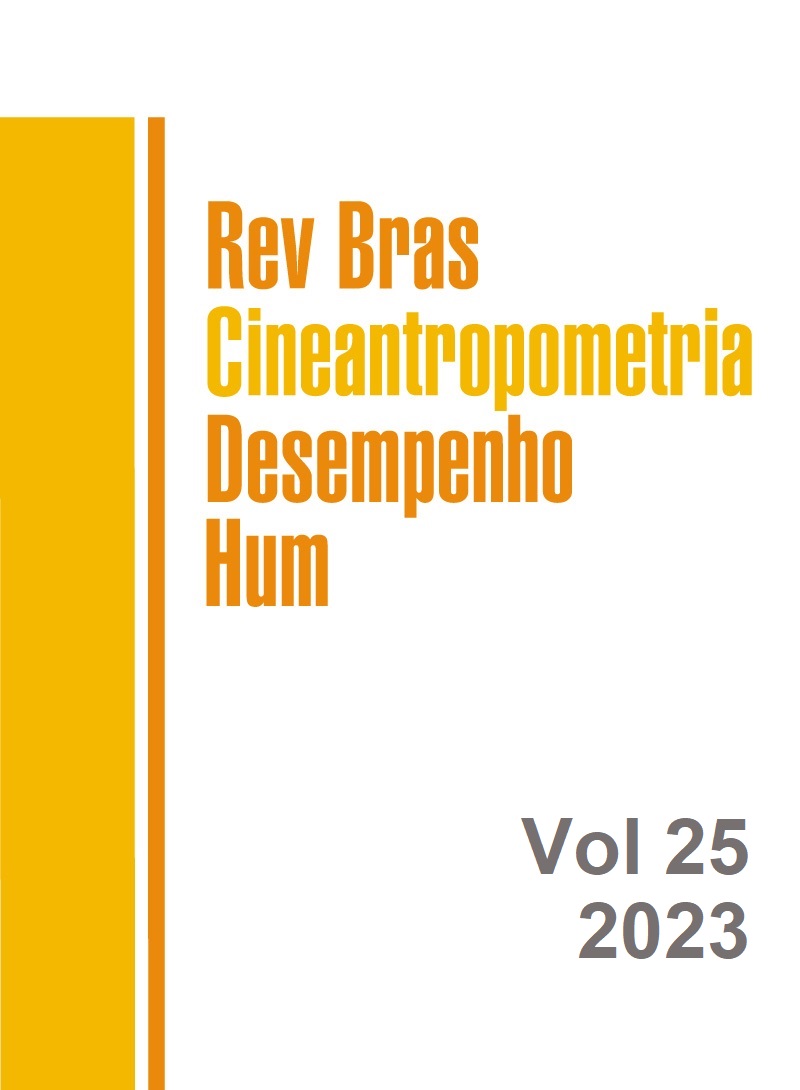Validity, reliability and measurement error of quadriceps femoris muscle thickness obtained by ultrasound in healthy adults: a systematic review
DOI:
https://doi.org/10.1590/1980-0037.2023v25e93936Palabras clave:
Atrophy, hypertrophy, UltrasonographyResumen
Due to its low cost and operational simplicity, ultrasound has been used to monitor muscle thickness in laboratory environments, rehabilitation clinics, and sports clubs. However, it is necessary to determine the measurement's quality to infer whether the possible changes observed are derived from the treatment or the measurement error. Therefore, we performed a systematic review to determine the validity, reliability, and measurement error of quadriceps femoris muscle thickness obtained by ultrasound in healthy adults. A search was conducted in the Pubmed, Web of Science, and Scopus databases until April 2022. The study selection process was carried out by two independent researchers, with the presence of a third researcher in case of disagreements. Twenty-six studies were eligible for the review, being 4 of validity, 4 of reliability only, and 18 of reliability and measurement error. The intraclass correlation coefficient ranged from 0.60 to 0.99 in validity studies and from 0.44 to 0.99 in reliability studies. The typical error of measurement ranged from 0.01 to 0.47 cm, and the coefficient of variation was from 0.5 to 17.9%. Four studies received "very good" classification in all the risk of bias analysis criteria. Therefore, it is concluded that the quadriceps femoris muscle thickness obtained by ultrasound was shown to be valid, reliable, and to have low measurement errors in healthy adults. The weighted average of the relative error was 6.5%, less than typical increases in resistance training studies. The raters' experience and methodological care for repeated measurements were necessary to observe low measurement errors.
Citas
Brandner CR, Clarkson MJ, Kidgell DJ, Warmington SA. Muscular adaptations to whole body blood flow restriction training and detraining. Front Physiol 2019;10.
Botton E, Radaelli R, Wilhelm EN, Rech A, Brown LE, Pinto RS. Neuromuscular adaptations to unilateral vs. bilateral strength training in women. J Strength Cond Res 2016;30(7):1924–32.
Lee JH, Cheon S, Jun HP, Huang YL, Chang E. Bilateral comparisons of quadriceps thickness after anterior cruciate ligament reconstruction. Medicina (Kaunas) 2020;56(7).
Yang JH, Eun SP, Park DH, Kwak HB, Chang E. The effects of anterior cruciate ligament reconstruction on individual quadriceps muscle thickness and circulating biomarkers. Int J Environ Res Public Health 2019;16(24).
O’Brien WD. Ultrasound - biophysics mechanisms. Prog Biophys Mol Biol 2007;93(1–3):212–55.
Larivière C, Gagnon D, de Oliveira E, Henry SM, Mecheri H, Dumas JP. Reliability of ultrasound measures of the transversus abdominis: effect of task and transducer position. PM R 2013;5(2):104–13.
Larivière C, Gagnon D, de Oliveira E, Henry SM, Mecheri H, Dumas JP. Ultrasound measures of the lumbar multifidus: effect of task and transducer position on reliability. PM R 2013;5(8):678–87.
Blazevich AJ, Gill ND, Zhou S. Intra- and intermuscular variation in human quadriceps femoris architecture assessed in vivo. J Anat 2006;209(3):289–310.
Enes A, Alves RC, Schoenfeld BJ, Oneda G, Perin SC, Trindade TB, et al. Rest-pause and drop-set training elicit similar strength and hypertrophy adaptations compared with traditional sets in resistance-trained males. Appl Physiol Nutr Metab 2021;46(11):1417–24.
Abe T, Dehoyos DV, Pollock ML, Garzarella L. Time course for strength and muscle thickness changes following upper and lower body resistance training in men and women. Eur J Appl Physiol 2000;81(3):174–80.
Ogasawara R, Thiebaud RS, Loenneke JP, Loftin M, Abe T. Time course for arm and chest muscle thickness changes following bench press training. Interv Med Appl Sci 2012;4(4):217–20.
Coratella G, Beato M, Bertinato L, Milanese C, Venturelli M, Schena F. Including the eccentric phase in resistance training to counteract the effects of detraining in women: a randomized controlled trial. J Strength Cond Res 2021;36(11):3023–31.
Stock MS, Olinghouse KD, Drusch AS, Mota JA, Hernandez JM, Akalonu CC, et al. Evidence of muscular adaptations within four weeks of barbell training in women. Hum Mov Sci 2016;45:7–22.
Ema R, Wakahara T, Miyamoto N, Kanehisa H, Kawakami Y. Inhomogeneous architectural changes of the quadriceps femoris induced by resistance training. Eur J Appl Physiol 2013;113(11):2691–703.
Trindade TB, Prestes J, Neto LO, Medeiros RMV, Tibana RA, de Sousa NMF, et al. Effects of pre-exhaustion versus traditional resistance training on training volume, maximal strength, and quadriceps hypertrophy. Front Physiol 2019;10.
Page MJ, McKenzie JE, Bossuyt PM, Boutron I, Hoffmann TC, Mulrow CD, et al. The PRISMA 2020 statement: an updated guideline for reporting systematic reviews. BMJ 2021;372(71):1–11.
Mokkink LB, Boers M, van der Vleuten CPM, Bouter LM, Alonso J, Patrick DL, et al. COSMIN Risk of Bias tool to assess the quality of studies on reliability or measurement error of outcome measurement instruments: a Delphi study. BMC Med Res Methodol 2020;20(293):1–13.
Betz TM, Wehrstein M, Preisner F, Bendszus M, Friedmann-Bette B. Reliability and validity of a standardized ultrasound examination protocol to quantify vastus lateralis muscle. J Rehabil Med 2021;53(7).
Mechelli F, Arendt-Nielsen L, Stokes M, Agyapong-Badu S. Validity of ultrasound imaging versus magnetic resonance imaging for measuring anterior thigh muscle, subcutaneous fat, and fascia thickness. Methods Protoc 2019;2(3):1–10.
Nijholt W, Jager-Wittenaar H, Raj IS, van der Schans CP, Hobbelen H. Reliability and validity of ultrasound to estimate muscles: a comparison between different transducers and parameters. Clin Nutr ESPEN 2020;35:146–52.
Worsley PR, Kitsell F, Samuel D, Stokes M. Validity of measuring distal vastus medialis muscle using rehabilitative ultrasound imaging versus magnetic resonance imaging. Man Ther 2014;19(3):259–63.
Descargas
Publicado
Número
Sección
Licencia

Direitos Autorais para artigos publicados nesta revista são do autor, com direitos de primeira publicação para a revista. Em virtude da aparecerem nesta revista de acesso público, os artigos são de uso gratuito, com atribuições próprias, em aplicações educacionais e não-comerciais, desde que seja dada a atribuição. Esta obra foi licenciada com uma Licença Creative Commons Atribuição 4.0 Internacional - CC BY


